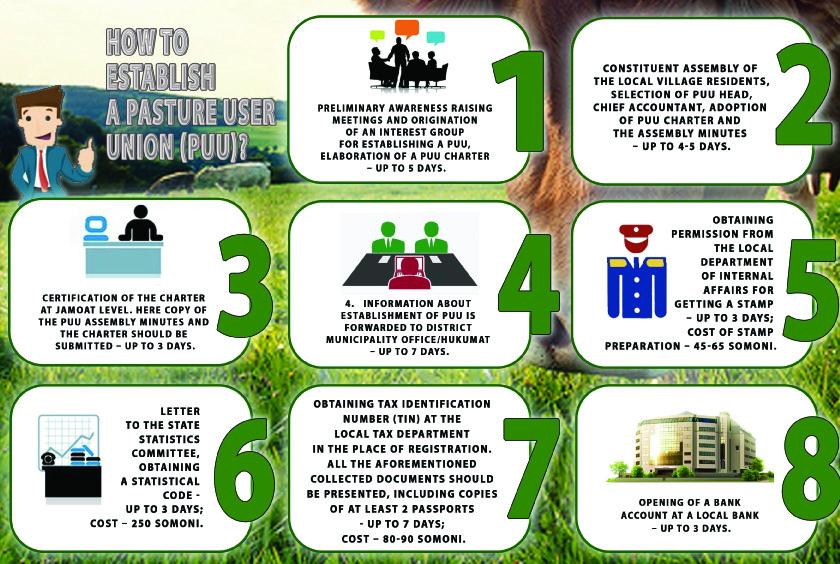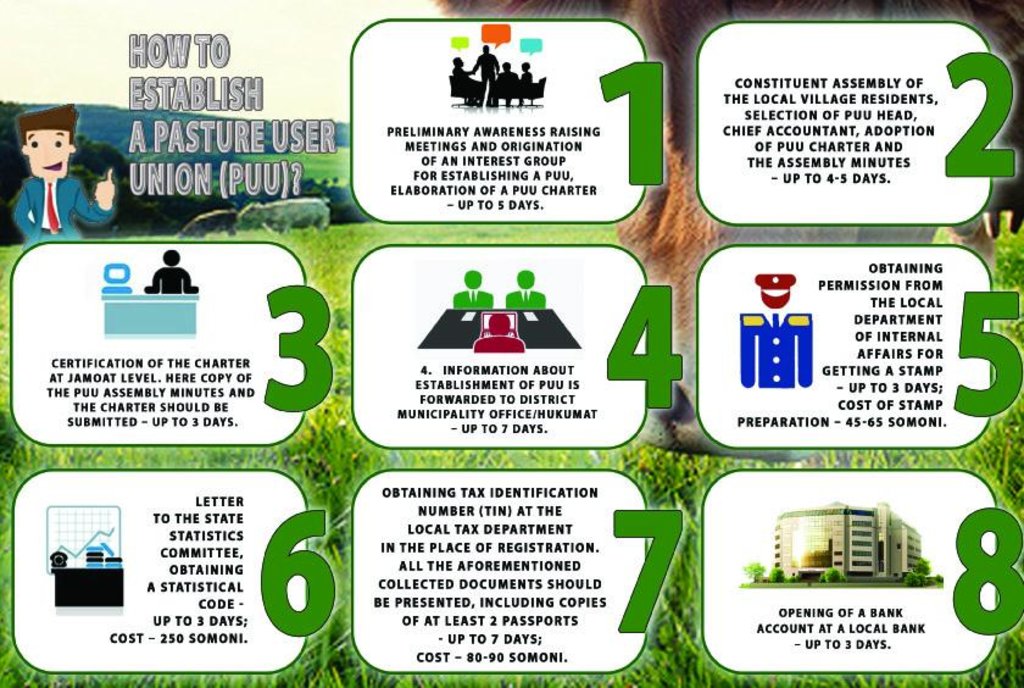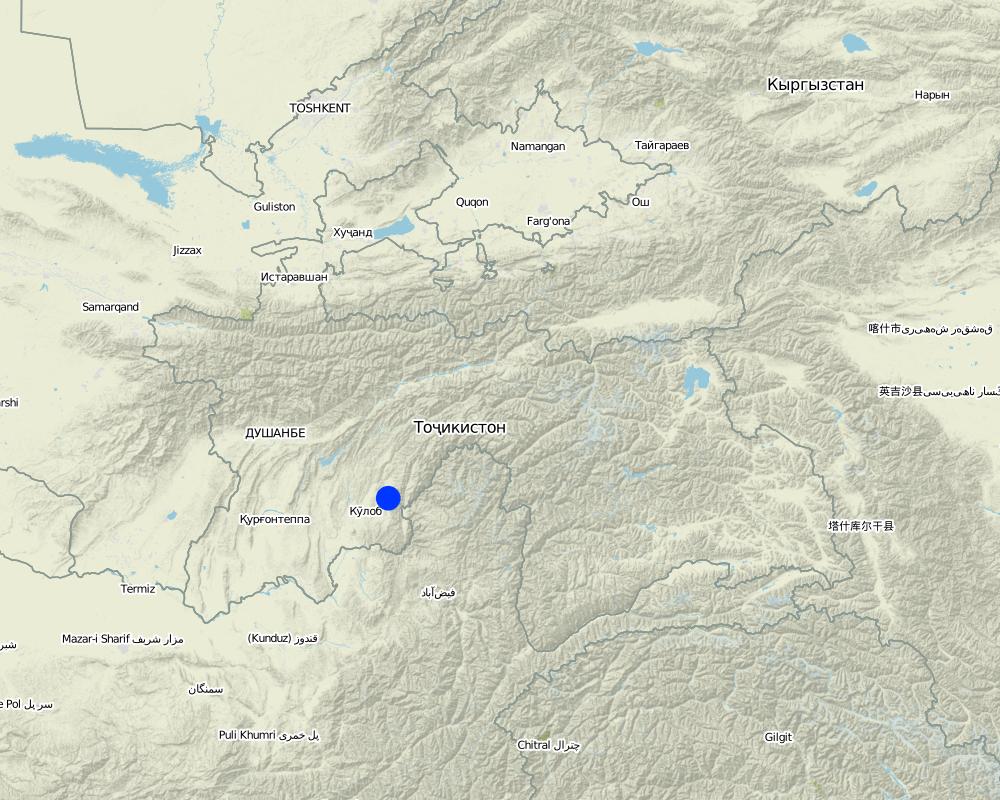Conversion of Village Livestock Committees into the legal Pasture User Unions [Таджикистан]
- Создание:
- Обновить:
- Составитель: Sa'dy Odinashoev
- Редактор: –
- Рецензент: David Streiff
Табдил додани Кумитаи Чорводории Деҳа ба Ҷамияти Чарогоҳ Истифодабарандагон
approaches_2539 - Таджикистан
Просмотреть разделы
Развернуть все Свернуть все1. Общая информация
1.2 Контактные данные специалистов и организаций, участвующих в описании и оценке Подхода
Название организации (-ий), содействовавших документированию/оценке Подхода (если применимо)
CARITAS (Switzerland) - Швейцария1.3 Условия, регламентирующие использование собранных ВОКАТ данных
Когда были собраны данные (на местах)?
15/01/2016
Составитель и ответственный/-ые специалист(-ы) согласны с условиями, регламентирующими использование собранных ВОКАТ данных:
Да
2. Описание Подхода УЗП
2.1 Краткое описание Подхода
Livestock committees were established with the goal to improve livestock health as well as natural resource management in the watersheds where the village pastures were situated. Livestock committees in the Muminabad district are organised at village level and coordinate their activities through the registered livestock association at district level.
2.2 Подробное описание Подхода
Подробное описание Подхода:
Aims / objectives: This approach applied by Caritas Switzerland, aimed to improve natural resource management in the watersheds through an organised effort of livestock owners. It encourages preventive measures against soil erosion by providing incentives for beneficiaries at community level. The process is managed by the livestock committees, who represent the animal owners at village level. The committees are responsible for organising livestock owners and managing the village pastures by applying rotational grazing principles, establishment of water points and rest places, ensuring safe paths for animals and easy access to pasture lands.
Stages of implementation: The project encompasses the following steps: 1) Competitive call for project proposals to improve livestock and pasture management through villager's efforts, 2) Expression of interest from community members to participate in the competition, 3) Development of project proposals from villagers with assistance of technical staff from the implementing agency (Caritas), 4) Selection and notification of winners, confirmation of village funding commitments, 5) A village general meeting for the inception of project and laying the foundation for the livestock committee, 6) Formalisation of partnership agreement with donor (signed agreements for project implementation), 7) Project implementation transfer into livestock committee’s responsibility, 8) Technical assistance through training and workshops, monitored by the implementing agency (Caritas), 9) Strengthening of the livestock committee as a community based organisation, 10) follow up and continued activity of livestock committee through other projects and self organised activities among livestock owners
Role of stakeholders: Various locals and village members are essential is assisting with the success of the project; The religious head (mullah) acts as a promoter of idea and mobilises the community through developing villager's interest; the village informal leader (vakil), helps to coordinate the activities; local organisations assist in informing and bringing people together for the meetings. The livestock committee consists of five members, including the appointed head shepherd. This has proven to be an effective size group. The main tasks of this committee include; mapping the pasture lands, organising rotational schemes, informing and training livestock owners of methods to improving pasture grazing, keeping villagers informed, establishing and collecting membership fees, keeping the accounts for the organisation, and application of funds (own or donor’s), develop new ideas and project proposals for further land improvement projects.
Other important information: The villagers are responsible for the labour contribution during the construction of water points or paths/roads. They pay membership fees, which cover the shepherd’s salary and the committee’s activities. They are kept informed of pasture grazing schemes, and control the performance of the committee.
2.3 Фотографии, иллюстрирующие Подход
2.5 Страна/ регион/ место, где применялся Подход
Страна:
Таджикистан
Административная единица (Район/Область):
Tajikistan/Khatlon
Более точная привязка места:
Muminabad
Map
×2.6 Даты начала и окончания реализации Подхода
Если год начала реализации Подхода достоверно неизвестен, дайте примерную оценку:
менее 10 лет назад (недавняя)
2.7 Тип Подхода
- в рамках проекта/ программы
2.8 Каковы цели/ задачи Подхода
The Approach focused mainly on SLM with other activities
The SLM Approach addressed the following problems: In Soviet time the pastures around the villages were belonging the village, but after the Soviet era all the land become private, individuals started to privatize the pasture lands around the village and people found out only after a month, during the payment day. The pastures belong to one person, if the herd of the village is grazing village have to pay. If the tax for one ha of pasture land is 1 USD, to private people they have to pay per cow 3.5 USD per month.
3. Участие и распределение ролей заинтересованных сторон
3.1 Заинтересованные стороны, участвующие в реализации Подхода и их роли
- местные землепользователи/ местные сообщества
- общественные организации
- государственные власти (отвечающие за планирование или принятие решений)
3.2 Участие местных землепользователей/ местных сообществ на разных стадиях реализации Подхода
| Участие местных землепользователей/ местных сообществ | Перечислите участников и опишите их вовлеченность | |
|---|---|---|
| инициирование/ мотивация | самоорганизация | |
| планирование | нет | |
| выполнение | нет | |
| мониторинг/ оценка | нет | |
| Research | нет |
3.4 Принятие решений по выбору Технологии/ Технологий УЗП
Укажите, кто принимал решение по выбору применяемой Технологии/ Технологий:
- в основном землепользователи при поддержке специалистов по УЗП
Поясните:
Decisions on the method of implementing the SLM Technology were made by mainly by land users supported by SLM specialists
4. Техническая поддержка, повышение компетенций и управление знаниями
4.1 Повышение компетенций/ обучение
Проводилось ли обучение землепользователей/ других заинтересованных лиц?
Да
Укажите, кто проходил обучение:
- землепользователи
- местный персонал/консультанты
Тип обучения:
- в ходе работы
- обмен опытом между фермерами
- опытные участки
- общие собрания
4.2 Консультационные услуги
Есть ли у землепользователей возможность получать консультации?
Да
Описание/ комментарий:
Advisory service is quite adequate to ensure the continuation of land conservation activities
4.3 Институциональная (организационная) поддержка
В ходе реализации Подхода были ли организованы новые институциональные структуры или поддержаны уже существующие?
- да, существенно
Укажите уровень, на котором структуры были укреплены или вновь созданы:
- местные
Укажите тип поддержки:
- повышение компетенций/ обучение
4.4 Мониторинг и оценка
Являются ли мониторинг и оценка частью Подхода?
Да
Комментарии:
bio-physical aspects were regular monitored by project staff, land users through observations; indicators: None
bio-physical aspects were regular monitored by project staff, land users through measurements; indicators: None
technical aspects were regular monitored by project staff, land users through observations; indicators: None
technical aspects were regular monitored by project staff, land users through measurements; indicators: None
socio-cultural aspects were regular monitored by project staff, land users through observations; indicators: None
socio-cultural aspects were regular monitored by project staff, land users through measurements; indicators: None
economic / production aspects were regular monitored by project staff through observations; indicators: None
economic / production aspects were regular monitored by project staff, land users through measurements; indicators: None
area treated aspects were regular monitored by project staff, land users through observations; indicators: None
area treated aspects were None monitored by project staff, land users through measurements; indicators: None
no. of land users involved aspects were None monitored by project staff, land users through observations; indicators: None
no. of land users involved aspects were None monitored by None through measurements; indicators: None
There were few changes in the Approach as a result of monitoring and evaluation: Involvement of the local mosque.
There were few changes in the Technology as a result of monitoring and evaluation: Setting a side big amount of the pastures.
4.5 Научные исследования
Были ли научные исследования частью Подхода?
Нет
5. Финансирование и внешняя материальная поддержка
5.1 Годовой бюджет мероприятий по УЗП в рамках Подхода
Если точный годовой бюжет неизвестен, укажите примерный диапазон затрат:
- 10000-100000
Комментарий (например, основные источники финансирования/ ключевые доноры):
Approach costs were met by the following donors: international non-government: 60.0%; local community / land user(s): 40.0%
5.2 Финансирование и внешняя материальная поддержка, предоставляемая землепользователям
Предоставлялась ли землепользователям финансовая/ материальная поддержка для применения Технологии /Технологий?
Да
5.3 Субсидии на отдельные затраты (включая оплату труда)
- оборудование
| Укажите, какие ресурсы были субсидированы | В какой степени | Опишите субсидии подробнее |
|---|---|---|
| техника | профинансированы частично | |
| инвентарь/ инструменты | профинансированы частично | |
- сельскохозяйственные
| Укажите, какие ресурсы были субсидированы | В какой степени | Опишите субсидии подробнее |
|---|---|---|
| семена | профинансированы полностью | |
| удобрения | профинансированы полностью | |
- строительные материалы
| Укажите, какие ресурсы были субсидированы | В какой степени | Опишите субсидии подробнее |
|---|---|---|
| камень | профинансированы полностью | |
| древесина | профинансированы полностью | |
Если труд землепользователя был существенным вкладом, укажите, был ли этот вклад:
- добровольный
5.4 Кредитование
Предоставлялись ли в рамках Подхода кредиты на мероприятия УЗП?
Нет
6. Анализ влияния и заключительные положения
6.1 Влияние Подхода
Сумел ли Подход помочь землепользователям внедрить и поддерживать технологии УЗП?
- Нет
- Да, немного
- Да, умеренно
- Да, существенно
Decreasing of runoff, increase of soil cover, increase of fodder crops and rehabilitation of the gullies.
Сумел ли Подход расширить возможности социально и экономически уязвимых групп?
- Нет
- Да, немного
- Да, умеренно
- Да, существенно
Сумел ли Подход разрешить правовые проблемы землевладения/ землепользования, препятствующие использованию технологий УЗП?
- Нет
- Да, немного
- Да, умеренно
- Да, существенно
At the beginning the spring where the livestock was drinking water open the livestock were destroying the
Did other land users / projects adopt the Approach?
- Нет
- Да, немного
- Да, умеренно
- Да, существенно
Did the Approach lead to improved livelihoods / human well-being?
- Нет
- Да, немного
- Да, умеренно
- Да, существенно
Did the Approach help to alleviate poverty?
- Нет
- Да, немного
- Да, умеренно
- Да, существенно
6.2 Основные причины, побуждающие землепользователей внедрять УЗП
- рост продуктивности
Increase livestock production
- рост прибыли (доходности) и рентабельности
- снижение объёма работ
Less working for livestock
- экологическая сознательность
- well-being and livelihoods improvement
More income for the farmers
6.3 Долгосрочная устойчивость мероприятий в рамках Подхода
Могут ли землепользователи самостоятельно (без внешней поддержки) продолжать применение того, что было реализовано в рамках Подхода?
- да
Если да, опишите как:
PUUs are officially registered, all the pastures around the village belong to them. At the end of the year they have to pay taxes.
Ссылки и модули
Развернуть все Свернуть всеСсылки
Нет ссылок
Модули
Нет модулей





